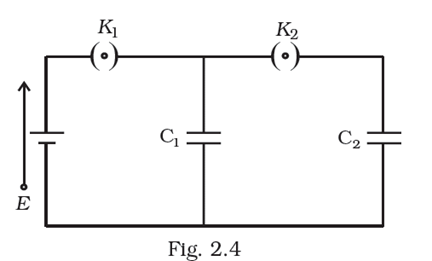In the circuit shown in Fig. 2.4. initially key K1 is closed and key K2 is open. Then K1 is opened and K2 is closed (order is important).
[Take Q1’ and Q2’ as charges on C1 and C2 and V1 and V2 as voltage respectively.]

Then
In first case, K1 is closed and K2 is open. So the circuit is effectively

The capacitor C1 gets charged due to the battery E. Let charge Q be there on C1, then
![]()
In the second case, the key K1 is open and K2 is closed. The circuit now can be redrawn as

The capacitor C2 will get charged due to the charge on C1. If Q1’ and Q2’ are the final charges on C1 and C2 respectively, from conservation of charge, we can say that option (d) is correct.
Also, we know that Q1’=C1V1 and Q2’=C2V2, the sum of which is equal to Q which is equal to C1E. Thus, option (c) is correct.
The potential across C1 and across C2 will also be same because they are connected in parallel to each other. Thus, option (a) is correct.
Option (b) can be correct if and only if C1 and C2 have the same value. Thus, in this case it is incorrect.